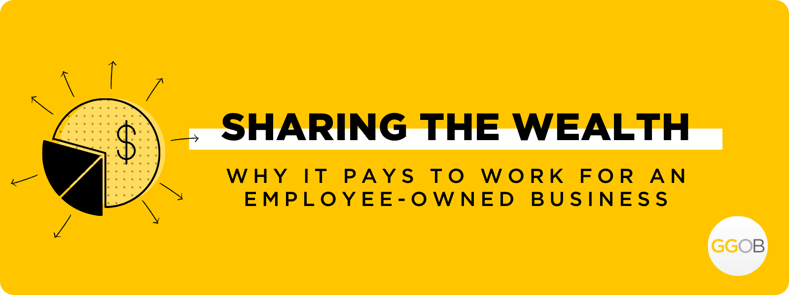
SRC Celebrates 40 Years In Business—And The Best Is Yet To Come
The employee-owners of SRC have a lot to celebrate this year. Not only does 2023 mark the company’s 40thanniversary, but the ten businesses that comprise SRC Holdings continue to set records with their performance despite the challenges of high inflation, soaring interest rates, and continued supply chain challenges.
SRC’s remarkable success was driven home on the evening of June 22, 2023, when many of the company’s 2,000 associates gathered to learn the latest stock price of their business. Unlike companies traded on public exchanges, SRC is 100% owned by an employee stock ownership plan, or ESOP, which is a retirement benefit for participants.
Every year, companies with an ESOP are required to contract with a third party to update the value of their business. The SRC associates, many with family members in tow, gathered to hear the results of that valuation, which drives the stock price of the shares in the ESOP held by the associates.
Jack Stack, the president and CEO of SRC Holdings, stood at a podium to deliver the big news: the company’s value leapt by 20% over the past year.
The crowd gasped, and then went wild with applause.
“You have built an outrageously successful company over the past 40 years,” Stack told the audience. “And you have positioned yourself for one heckuva run for the future.”
In other words, for the employee-owners at SRC, the best is yet to come.

More than 600 employee-owners and family members attended SRC’s Annual Shareholder Meeting.
Beating The Odds
The SRC story is possibly unique in the annals of business, especially when you consider the long odds the company faced when it spun out of its parent company, International Harvester, back in 1983. SRC, which was originally called Springfield Remanufacturing Corporation, began with 119 employees and a ton of debt. Their debt-to-equity ratio was 89-to-1. A single misstep like a missed loan payment would end the company’s journey just as it was getting started.
“It was wild 40 years ago,” Stack told the audience. “If you think the economic conditions we have today are bad, you need to multiply that by three to understand what it was like back then. There was incredible pain and suffering everywhere as companies like International Harvester laid thousands and thousands of people off every week—for more than two years.”
It's hard to keep a business going for a long time even during good economic times. Most businesses fail within their first year, while a mere 25% of businesses make it past their fifth birthday. Even big-name companies aren’t immune. The average lifespan of the largest publicly-held companies is just 14 years, according to a study of the Standard & Poor’s 500 index conducted by the consulting company McKinsey.
That’s why SRC’s 40th anniversary is such a big deal. Few companies can boast a track record of shifting from surviving to thriving quite like SRC can.
Since 1983, SRC’s stock price has increased by 1,079,900%.
Consider if you had $1,000 to invest back in 1983. If you had chosen to put that money into an S&P 500 Index fund, you’d have $53,927 today. Better yet, if you had used that $1,000 to buy stock in Berkshire Hathaway, Warren Buffet’s company, you would have generated $501,148 with that investment. Now, if you put that same amount of money into SRC, you would now have $10.8 million—a figure that boggles the mind.
What’s critical to recognize is that the wealth that SRC has created over the past 40 years has been shared among its employee-owners—not outside investors.
“We wanted to give the wealth to the people who create the wealth,” says Stack. “This is our way of closing the gap between the haves and the have-nots.”
SRC has paid out some $175 million over the past 40 years to those employee owners who retired or left the company. More than a few of those retirees left as millionaires, thanks to their shares in the ESOP.
.png?width=750&height=563&name=SRC+Holdings+Shareholder+Meeting+(2).png) Retired employee-owner Rick Hedden poses with his first SRC stock certificate from 1983.
Retired employee-owner Rick Hedden poses with his first SRC stock certificate from 1983.
“Working for an employee-owned company is a way to take a step toward fulfilling your own version of the American Dream,” says Stack. “It has a snowball effect that is truly changing lives all the way down the line—and it’s still rolling.”
Demystifying Business
Not only has SRC generated substantial wealth for its employee-owners, but the company has also never laid a single employee off over its 40 years—a period that spans four recessions and the pandemic. In fact, the company absorbed a $15 million hit to its earnings in 2020 to ensure that everyone retained their job.
Stack credits SRC’s ability to create and preserve jobs over the long run to its ownership culture—which is built upon embracing practices like financial transparency, business literacy education, score keeping, contingency planning, forecasting the future, and sharing the wealth. These are the foundations for The Great Game of Business, the communication and leadership system that SRC pioneered back in 1983 to teach every one of its associates how to think and act like an owner of their business. That education begins with demystifying the language of business.
“Our playbook is nothing more than understanding business,” says Stack. “When we opened the books, we opened the hearts of the people inside the organization. We use our playbook to effectively communicate in a clear and precise way that drives the emotions out of the equation. The crazy thing is that the more we teach our people, the more they teach us.”
As Stack wrote in The Great Game of Business, the story of SRC’s early years which he co-authored with Bo Burlingham, he wanted to appeal to the highest level of thinking among his associates:
The Great Game of Business creates an environment in which you can appeal to people’s best instincts, in which you ask them to rise above the day-to-day frustrations, and use all of their intelligence, ingenuity, and resourcefulness to help each other reach common goals. Ironically, it is also when employees are happiest and most productive.
“We want to get everyone singing from the same song sheet,” says Stack, “because it takes everyone working together to achieve dynamic outcomes.”
Forecasting The Future
The mistake many people make when they read Stack’s book—which continues to influence business leaders around the world to this day—is that SRC is the same company it was back in 1983. What they miss is the incredible evolution the business has undergone over the past 40 years, which includes starting and spinning off more than 60 separate businesses.
SRC has also doubled the value of the business five years after each significant economic hiccup it has weathered.
Another overlooked aspect of the SRC story is that the people featured in the book—the ones who helped Stack start the company—are largely retired. SRC is now on its second and even third generation of employee owners. Just 31% of SRC’s associates have been with the company for more than five years—while 69% joined less than five years ago.
This next generation of employee owners are now charting the future of SRC—all of whom have a voice in influencing where the company will grow into the future.
“The strategy of this company comes from you,” Stack told his associates. “You get to decide what you want to be when you grow up.”
Twice a year, the company gathers to discuss its collective five-year sales forecasts, strategies for growth, and contingency plans—a process they call High Involvement Planning. It’s also the time they talk about their continued efforts to diversify the business, such as reporting on the real estate investments the company has made over recent decades—which now cover more than 200 acres and four million square feet of floor space—most of which is owned by the associates.
.png?width=750&height=563&name=SRC+Holdings+Shareholder+Meeting+(1).png)
Associates at NewStream Enterprises discuss the 5-year strategy and sales plan.
It is those property holdings in tandem with the company’s financial growth and performance—SRC has been profitable for 39 years in a row—that shape the value of each associate’s shares in the ESOP.
“When you realize how strong the talent is in this company, you will be unstoppable in the years to come,” Stack told his associates. “The table is set for you to continue to grow this business. We’ve never been in such a strong position to dictate the future. My dream is that each of you gets to retire with millions of dollars of stock—and then pass the baton on to the next generation.”
Here's to SRC’s next 40 years—and beyond.
What does it take to build an ownership culture? Learn the 5 rules in this white paper!
More articles you might like:
.png)








.png)




-5.png)

